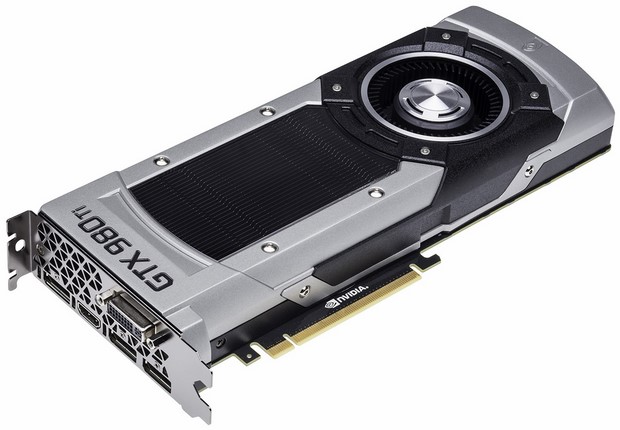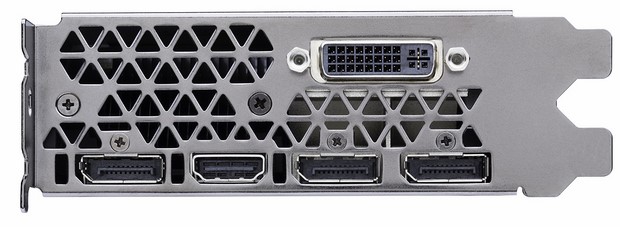NVIDIA GeForce GTX 980 Ti Review: A Cheaper Titan X Arrives
Introduction and Specifications
When NVIDIA launched the GeForce GTX Titan X a few weeks back, it did a couple of things. In addition to releasing the fastest single-GPU-powered graphics card we have seen to date, it also created a huge gap in NVIDIA’s desktop GPU line-up. The GeForce GTX 980 can be had for about $530 give or take a few bucks (though that will be changing after today). The GeForce GTX Titan X, however, landed at a cool $1000. That’s a big price gap to leave empty. Consider the Titan X’s massive 12GB of memory and the fact that its GPU leverages all available resources of the GM200 design, and it becomes obvious that a card with less memory and fewer CUDA cores could easily drop in between the GTX 980 and Titan X and fill that gap.
And that’s just what NVIDIA is doing with the GeForce GTX 980 Ti.
Today, we’re able to lift the veil on the Titan X’s closest sibling, the GeForce GTX 980 Ti. Like the Titan X, this card is packing NVIDIA’s most powerful, single-GPU, though a few things have been tweaked here and there to bring the price point down to more approachable levels. As you’ll see a little later though, performance remains very strong. First up, some specs and a look at the card, followed by a few new feature announcements and, of course, some benchmarks and overclocking...
And that’s just what NVIDIA is doing with the GeForce GTX 980 Ti.
Today, we’re able to lift the veil on the Titan X’s closest sibling, the GeForce GTX 980 Ti. Like the Titan X, this card is packing NVIDIA’s most powerful, single-GPU, though a few things have been tweaked here and there to bring the price point down to more approachable levels. As you’ll see a little later though, performance remains very strong. First up, some specs and a look at the card, followed by a few new feature announcements and, of course, some benchmarks and overclocking...
|
| NVIDIA GeForce GTX 980 Ti | ||
| Graphics Processing Clusters | 6 | |
| Streaming Multiprocessors | 22 | |
| CUDA Cores (single precision) | 2816 | |
| Texture Units | 176 | |
| ROP Units | 96 | |
| Base Clock | 1000MHz |
|
| Boost Clock | 1075MHz |
|
| Memory Clock (Data rate) | 3505MHz (Effective Speed - ~7Gbps) | |
| L2 Cache Size | 3072KB | |
| Total Video Memory | 6144 MB GDDR5 | |
| Memory Interface | 384-Bit |
|
| Total Memory Bandwidth | 336.5 GB/s |
|
| Texture Filtering Rate (Bilinear) | 176 GigaTexels/sec |
|
| Fabrication Process | 28 nm |
|
| Transistor Count | 8 Billion | |
| Connectors |
3 x Display Port |
|
| Form Factor | Dual Slot |
|
| Power Connectors | One 6-Pin, One 8-Pin | |
| Recommended Power Supply | 600 Watts |
|
| Thermal Design Power (TDP) | 250 Watts |
|
| Thermal Threshold | 92°C |
|
| Price | $649 MSRP - Find Them At Amazon | |
The new GeForce GTX 980 Ti looks much like previous-gen GeForce GTX-branded graphics cards that feature NVIDIA’s silver, in-house reference cooler. And the card is packing the very same GPU as the recently launched GeForce GTX Titan X, though a few of its functional blocks have been disabled.
The GeForce GTX Titan X has a base clock of 1000MHz and a Boost clock of 1075MHz--the GPU clocks remain the same on the GeForce GTX 980 Ti. Whereas the GM200 GPU on the Titan X is packing 3072 CUDA cores, 192 texture units, 96 ROPs, and 12GB of fast 7GHz (effective GDDR5 data rate) memory, the GeForce GTX 980 Ti has 2816 CUDA cores, 176 texture units, 96 ROPs, and 6GB of on-board memory. The reduction in cores and texture units is because two of the GM200's Streaming Multiprocessor units are disabled on the 980 Ti.
Like the Titan X, the GeForce GTX 980 Ti's memory links to the GPU via a wide 384-bit interface. At its reference clocks, the 980 Ti offers up a peak textured fillrate of 176 GTexels/s and 336.5 GB/s of memory bandwidth; those numbers are significantly higher than the GeForce GTX 980, but might seem low in light of the GeForce GTX 780 Ti’s 210 GTexels/s and 336 GB/s of memory bandwidth, but NVIDIA’s Maxwell architecture has other advantages which aid in performance and efficient utilization of resources.
There is more to Maxwell and the GM200 than just tech specs, however. Since we have covered many of the new features in NVIDIA’s “big” Maxwell GPUs, we won’t do it again here, but will point you to our GeForce GTX 980 launch piece and to our Titan X review, in which we cover NVIDIA’s new memory compression technology, VXGI, Dynamic Super Resolution, MFAA, and VR Direct-related features like Asynchronous Warp.
Like all of NVIDIA’s high-end graphics cards from the past few generations, the new GeForce GTX 980 Ti is outfitted with a heavy-duty cooler with frames and plates made of aluminum to add rigidity. Unlike the GeForce GTX 980, however, the Titan X does NOT feature a backplate. NVIDIA tells us the additional space consumed by the backplate is detrimental to cooling performance in multi-GPU configurations, so they did away with it on the 980 Ti, as they did with the Titan X.
As is the case with the last few generations of high-end cards, the GeForce logo along the top edge of the 980 Ti lights up and there is an embossed badge at the front of the fan shroud with the card's name. For the most part, the 980 Ti looks much like the GeForce GTX 980 and older 700-series cards, when fully assembled.
The actual cooling hardware on the cards consists of a large vapor chamber with a densely packed, nickel-plated aluminum finstack, and a large, rear-mounted barrel-type fan with user-adjustable fan curves. Like NVIDIA’s previous-gen flagships, the GeForce GTX 980 Ti also uses low-profile components on a large portion of the PCB around the GPU. The card’s cooler has a flat, ducted baseplate for minimally-obstructed airflow, which minimizes turbulence and helps quiet down and better cool the card. The chokes used in the 980 Ti are also epoxy coated, which help minimize the whine and buzz sometimes heard when a graphics card is under heavy load.
There is a window cut into the fan shroud that shows off the finstack (under a sheet of Lexan), and due to the fan configuration, virtually all of the heat produced by the card is exhausted from the system. Cards with centrally mounted axial-type fans expel some of the heated air from the system, but dump the rest back into the case.
As evidenced by the pair of SLI edge connectors at the top of the card, the GeForce GTX 980 Ti supports up to 4-Way SLI, and because the TDP of the card is only 250 watts, one 6-pin and one 8-pin supplemental PCI Express feeds are all that are required to power the card. We should note that the 980 Ti has a power balancing feature that allows the card to direct power from whichever feeds have headroom, when under load. The card receives power from three sources—the two supplemental PCIe feeds and the PCIe slot itself. Should one become overloaded when overclocking, for example, power can be utilized from one of the other feeds, if it’s available.
Outputs on the reference cards consist of a single dual-link DVI output, three full-sized DisplayPort outputs, and an HDMI connector—four of which can be utilized at any given time. The GeForce GTX 980 Ti has enough horsepower to push multiple displays simultaneously, and as such, it supports NVIDIA's 3D Vision Surround technology. Like other GTX-class GPUs, the 980 Ti is ready for NVIDIA’s G-Sync technology and everything else Maxwell has to offer as well. There’s some new stuff to talk about too.












